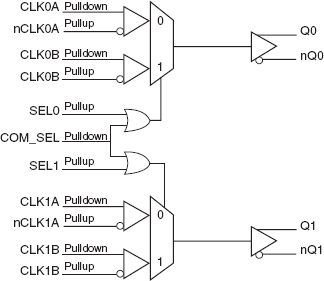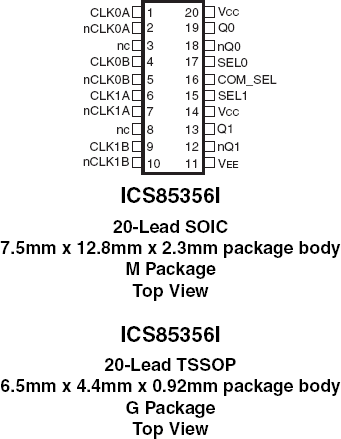Features
- High speed differential multiplexer. The device can be configured as a 2:1 multiplexer
- Dual 3.3V LVPECL outputs
- Selectable differential CLKx/nCLKx input pairs
- Differential CLKx/nCLKx pairs can accept the following interface levels: LVPECL, LVDS, LVHSTL, HCSL, SSTL
- Output frequency: 900MHz (typical)
- Translates any single-ended input signal to 3.3V LVPECL levels with resistor bias on nCLKx input
- Output skew: 75ps (typical)
- Propagation delay: 1.15ns (typical)
- LVPECL mode operating voltage supply range: VCC = 3V to 3.8V, VEE = 0V
- ECL mode operating voltage supply range: VCC = 0V, VEE = -3V to -3.8V
- -40°C to 85°C ambient operating temperature
- Available in lead-free (RoHS 6) package
Description
The 85356I is a dual 2:1 Differential-to-LVPECL Multiplexer. The device has both common select and individual select inputs. When COM_SEL is logic High, the CLKxx input pairs will be passed to the output. When COM_SEL is logic Low, the output is determined by the setting of the SEL0 pin for channel 0 and the SEL1 pin for Channel 1. The differential input has a common mode range that can accept most differential input types such as LVPECL, LVDS, LVHSTL, SSTL, and HCSL. The 85356I can therefore be used as a differential translator to translate almost any differential input type to LVPECL. It can also be used in ECL mode by setting VCC = 0V and VEE to -3.0V to - 3.8V. The 85356I adds negligible jitter to the input clock and can operate at high frequencies in excess of 900MHz thus making it ideal for use in demanding applications such as SONET, Fibre Channel, 1 Gigabit/10 Gigabit Ethernet.
Applied Filters:



